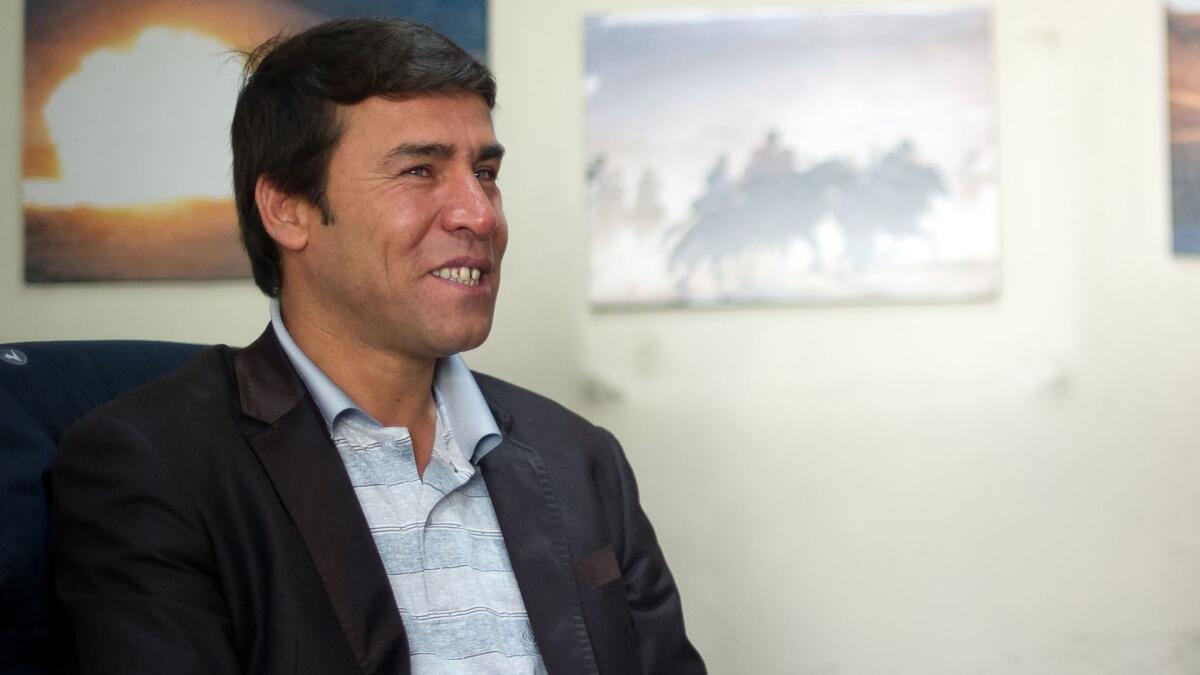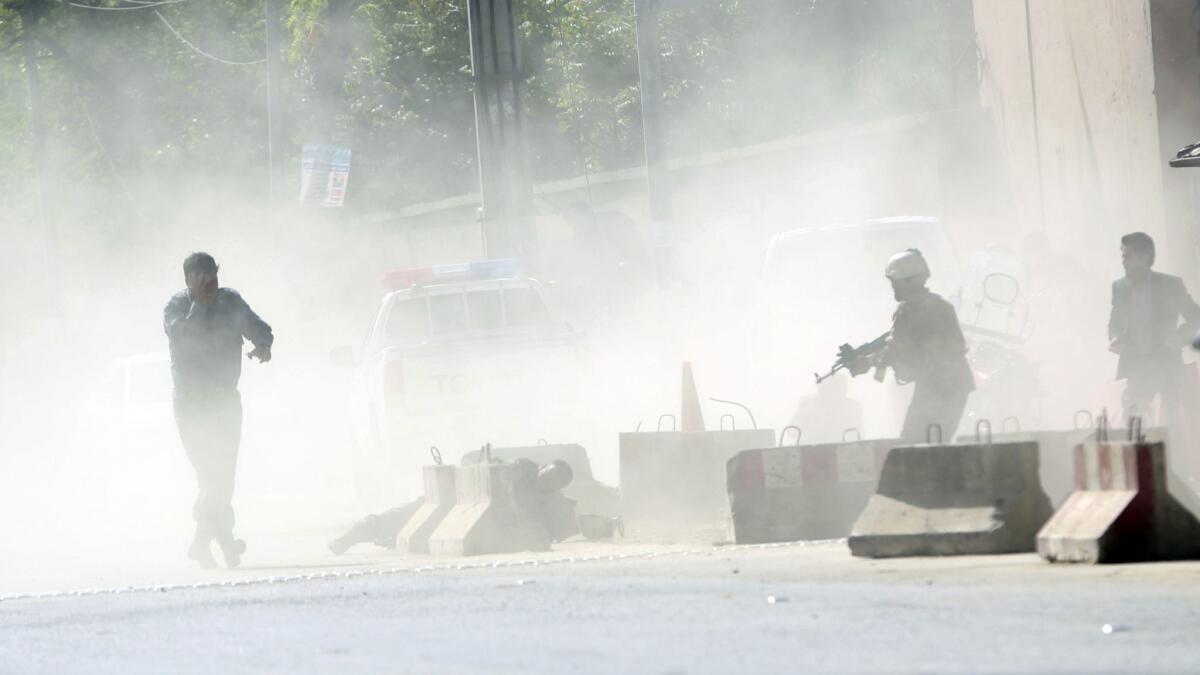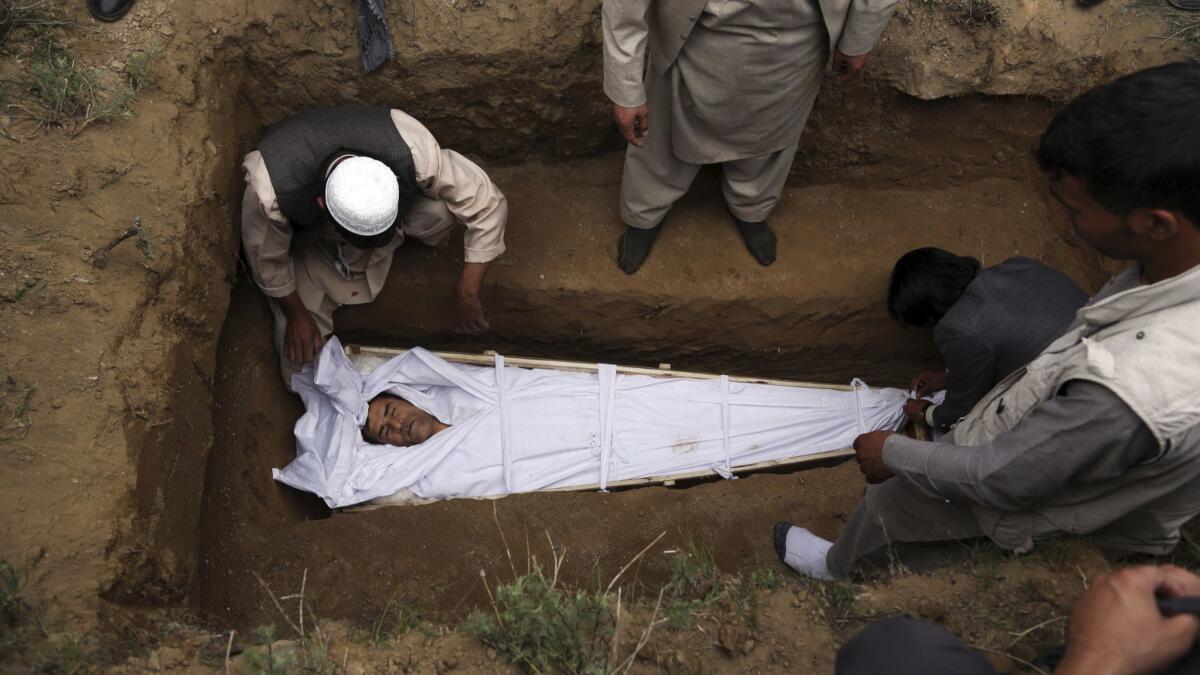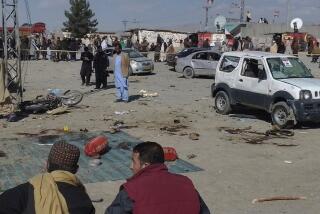Double Kabul suicide bombing kills 25, including nine journalists

- Share via
Reporting from KABUL, Afghanistan — A coordinated double suicide bombing by the militant group Islamic State hit central Kabul on Monday morning, killing at least 25 people, including nine Afghan journalists, officials said.
An AFP photographer, a cameraman for the local Tolo TV station and several reporters for the Afghan branch of Radio Free Europe were among the fatalities, police said.
At least 45 people were wounded in the twin attacks, according to a Kabul police spokesman, Hashmat Stanekzai, who also said four policemen were among those killed.
The attack was the latest in a relentless string of deadly large-scale bombings and assaults that have struck Kabul and elsewhere in Afghanistan this year. And even as the Afghan capital reeled from Monday’s assault, a suicide car bombing a few hours later in the southern province of Kandahar killed 11 children, a police spokesman said. Eight Romanian soldiers with the North Atlantic Treaty Organizaton were wounded in that bombing.
In a statement posted on an Islamic State-affiliated website, the militant group said two of its martyrdom seekers carried out the Kabul bombings, targeting the headquarters of the “renegade” Afghan intelligence services.
Meanwhile, an American soldier was killed and another wounded during a combat operation in eastern Afghanistan, the U.S. military reported.
The military said in a statement that “several” Afghan security forces were killed and wounded in the same operation Monday.
Gen. John W. Nicholson, the commander of U.S. forces in Afghanistan, said “their valiancy in battle, and that of the brave Afghan partners they fought alongside, will endure in our hearts and history.”
The statement said the wounded soldier is in stable condition.

The blasts in Kabul took place in the central Shash Darak area, home to NATO headquarters and a number of embassies and foreign offices — as well as the Afghan intelligence service.
Stanekzai, the police spokesman, said the first suicide bomber was on a motorbike; the second explosion was meant to hit those scrambling to get to the scene to help the victims of the first blast.
The second attacker was on foot, in a crowd of reporters rushing to the site of the first attack, pretending to be a member of the media, the spokesman said. The bomber then detonated his explosives while still among the reporters, Stanekzai said, intentionally targeting journalists.
Agence France-Presse said the news agency’s chief photographer in Kabul, Shah Marai, was among those killed. AFP said Marai died in a blast that struck journalists who had rushed to the scene of the earlier attack.

Media watchdog Reporters Without Borders said that along with the nine journalists killed, six were wounded. However, Sediqullah Tawhidi, an official with the Afghan Journalists Safety Committee, said only five journalists were wounded. Conflicting casualty tolls are common in the immediate aftermath of big attacks.
The Paris-based group named the journalists, working for media organizations from multiple countries, adding that Monday’s attack was the deadliest targeting of reporters since the fall of the Taliban in 2001. The watchdog group, also known by its French acronym RSF, said 36 media workers have been killed in Afghanistan in attacks by Islamic State or the Taliban since 2016.
RSF urged the Afghan government to do more to protect journalists.
United Nations spokesman Stephane Dujarric said the double suicide bombing “highlights once again the risks media professionals face in carrying out their essential work.”
Dujarric said in a statement that those responsible for Monday’s attacks in Kabul and Kandahar province “must be swiftly brought to justice.”
Survivors and witnesses recounted scenes of mayhem.
Jawed Ghulam Sakhi, a 28-year-old taxi driver, said “when the explosion happened, everywhere was covered with dust and fire, it was such a horrific scene” with bodies and body parts “thrown about on the street and the pavement.”
“I saw journalists covered with blood, this time they targeted the media,” Sakhi added.
Masouda, a young woman who was with her husband nearby, assailed the authorities. Her husband was wounded and was taken to the Wazir Akbar Khan hospital.
“I don’t know who is responsible for all these attacks, every day we lose our loved ones and no one in this government is taking responsibility for the killing of these innocent people,” she said.
Afghan President Ashraf Ghani condemned the attacks. The presidential palace released a statement saying that attacks targeting innocent civilians, worshipers inside the mosques, national and democratic processes, reporters and freedom of speech all are war crimes.
The U.S. Embassy also condemned the “savage bombings” in Kabul and reiterated its support for the Afghan people and Ghani’s government in their fight against terrorism.
“We extend our deepest condolences to the families, friends and colleagues of all the victims, including a number of brave journalists among the dead and injured,” it said, adding that “where media are in danger, all other human rights are under greater threat.”
Kabul’s chief of police, Dawood Amin, said the area hit was quickly sealed off and authorities were investigating. Mohammad Mousa Zahir, director of Wazir Akbar Khan hospital, said several people injured in the blasts were being treated at his hospital.
In its claim of responsibility, the militant group’s Afghan affiliate, known as Islamic State in Khorasan Province, said the first martyrdom seeker detonated his explosives vest near the intelligence service in central Kabul, forcing officers to head to the area of the explosion. The statement said the second attacker detonated his explosives vest after that. The statement, which exaggerated the overall death toll, as militant claims often do, did not say journalists were specifically targeted.
In the Kandahar attack, an Afghan official said a suicide bomber targeted a NATO convoy in the district of Daman but killed 11 children from a religious school nearby. The children had gathered around the NATO convoy for fun when the bomber struck, said Abdul Rahim Ayubi, a lawmaker from Kandahar.
Matiullah Helal, deputy spokesman for the provincial police chief, said 16 people were also wounded in that attack, including NATO soldiers, civilians and policemen.
Romania’s defense minister, Mihai Fifor, said eight Romanian troops with the “Carpathian Eagles” were among the wounded. NATO said the wounded service members, who are all in stable condition, were taken to Kandahar Airfield’s hospital for treatment.
Nicholson, the U.S. general who commands NATO’s Resolute Support mission, said in a statement that “if the enemies of Afghanistan think their cowardly actions will deter the commitment of the brave Afghan forces and our Resolute Support advisors, or the call by the Afghan people for peace, they are sorely mistaken.”
In other violence Monday, at least four Afghan policemen were killed in the northern province of Balkh, said Sher Mohammad Abu Tariq, the district chief in Nahri Shahi. The insurgents ambushed the police vehicle and fired rocket-propelled grenades.
Also, an Afghan police officer was killed and four people were wounded in an explosion in the eastern province of Nangarhar, said Attaullah Khogyani, spokesman for the provincial governor. He said the slain officer was the chief of the criminal investigations unit for Behsud district.
No one claimed responsibility for the other attacks. The Islamic State affiliate in Afghanistan first emerged in Nangarhar a few years ago, then expanded its footprint to elsewhere across the country.
Islamic State and the more firmly established Taliban carry out regular attacks, with the Taliban usually targeting the Afghan government and security forces and Islamic State targeting members of the country’s Shiite Muslim minority, whom the affiliate perceives as apostates.
The relentless assaults underscore the struggles that Afghan security forces have faced to rein in the militant groups since the United States and NATO concluded their combat mission at the end of 2014. Both militant groups want to establish strict Islamic rule in Afghanistan.
Last week, an Islamic State suicide bomber attacked a voter registration center in Kabul, killing 60 people and wounding at least 130 others. The fatalities included 22 women and eight children.
And the month before, an Islamic State suicide bomber targeted a Shiite shrine in Kabul where people had gathered celebrating the Persian New Year. That attack killed 31 people and wounded 65 others.
UPDATES:
4:12 p.m.: The article was updated with the death of a U.S. soldier and additional reaction to the blasts in Kabul.
7:38 a.m. April 30: This article was updated with the number of people wounded and killed in the bombing.
This article was originally published at 11:40 p.m. April 29.
More to Read
Sign up for Essential California
The most important California stories and recommendations in your inbox every morning.
You may occasionally receive promotional content from the Los Angeles Times.










